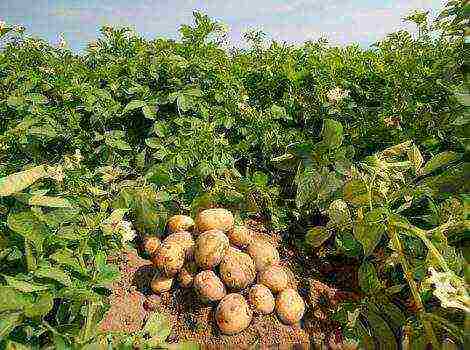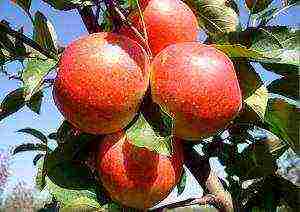Content
.
When planting leeks, determine the purpose for which you are growing the crop. Because the varieties of varieties differ in morphological and taste qualities. Leek varieties are divided into early, middle and late ripening times. A specific feature of the plant is that it does not form a standard bulb, only the stem is used for cooking. The light and dense stem has a pleasant aftertaste; onions are useful not only as a product for cooking, but also as a health product.

Leeks come in early, medium and late
General characteristics of leek varieties
Leek varieties are subdivided into three groups: early-ripening, mid-ripening and late-ripening. Planting of early varieties is harvested in late summer and early autumn. The leek grows rapidly, the length reaches one and a half meters. The foliage itself from the stem grows at an acute angle. The leaves are not densely arranged. Leek does not tolerate winter well. Medium ripeness varieties grow in mid-October. Leaves adhere tightly to the false stem. The stem itself reaches 20-25 cm in height, its thickness is up to 5 cm. The foliage is large and dense. The plant is winter-hardy, positively tolerates low temperatures down to -14 ° C. In areas with mild climates, farmers leave the mid-season leek in the ground until mid-winter, and remove it as needed.
Winter varieties are characterized by high winter hardiness. They grow slowly, the stem grows up to 15 cm. The foliage adheres tightly to the stem. Late leeks are harvested in late autumn and mid-spring. The cultivar has a long growing season and takes longer to ripen than other onion cultivars.
Leek varieties differ in both the length of the growing season and the time for the ripening of the crop, morphological characteristics and taste of the stem. Onions are enriched with beneficial minerals. Leek contains essential oils that increase appetite and have a positive effect on the functioning of the digestive system.

Leeks are very useful and widely used in cooking.
Leek varieties
Onions are popular with farmers. The variety of varieties allows you to grow onions for every taste. It is widely used in the preparation of salads, side dishes, various vegetable dishes, soups. Onions are used as a remedy for overweight, rheumatism and gout. It is used as a preventive measure. Onions are divided into early-ripening, mid-ripening and late-ripening varieties.
Farmers note that early leeks are the best, as they yield more yields than mid- and late-ripening varieties. In order to ripen early varieties need 3-4 months, regardless of the weather. The growing season for a leek of medium ripeness lasts 145-175 days and a dense arrangement of the plant develops. The width of the leaves is 5-7 cm blue-green. The leaves are located at a steep angle from the stem, not like in the early varieties. The standard leg length is 20-25 cm with a weight of about 170-250 grams. The yield of medium varieties is lower than that of early maturing ones, but the quality of the plant is better.
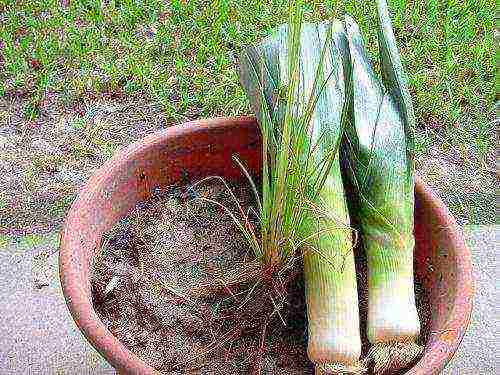
Leeks can be harvested about 4 months after planting.
Leek of early ripeness
Early varieties include Goliath, Kilima, Vesta, Columbus, Gulliver. Goliath is characterized by an average stem height, about 25-30 cm of the bleached part, 6 cm in diameter. Green and gray-green onions have wide leaves.The onion part is not very pronounced in the variety, it reaches a mass of 180-210 grams, but it is high-yielding. Harvesting should be in the middle of summer. Goliath belongs to a universal species, it is used fresh in food and dried. Due to weak immunity, it needs additional feeding from diseases and pests.
Kilima leek is harvested a little later than other species among the early varieties. A dense leg of about 25 cm and a diameter of 5-6 cm, reaches 150 gr.
Leek Vesta is grown mainly in the Moscow region. It has a pleasant semi-sharp taste and is universally applicable. The white part of the plant has a diameter of 2-3 cm, but is approximately 48-53 cm long. The mass reaches 200-250 grams. High immunity to disease. It tolerates both frost and hot weather there.
At Columbus, the height of the leaves reaches 75-80 cm, the total weight is about 350-400 grams. Without hilling, the white part forms on its own. It has a pleasant taste. The height of the bleached part in Gulliver's is 25-30 cm, the diameter of the stem is 4-5 cm, the total weight of the plant is 230-250 g. It is used fresh and canned.

Kilima leek gives dense, large legs
Mid-season leek
The leek of medium ripeness includes Casimir, Kamus, Bastion, Tango, Jolant, Winner, Elephant, Alligator, Bandit, Giraffe, Karatansky.
By itself, the bulbous part of the German Casimir is small or absent. The white part is of high quality, 20-27 cm, diameter 4-6 cm. The use is universal. It becomes juicier when stored. The Czech Kamus bulb is weakly expressed, the length of the white part is 19-23 cm, and the small diameter is 2-3 cm. Green leaves with a predominance of a slight purple hue. High immunity to fungal diseases. The yield is slightly lower than that of other mid-season varieties. Medium pungency in taste. The application is universal.
Leek Bastion of medium ripeness yields a harvest in 150-160 days. The foliage is gray-blue, green. The size of the onion is medium, the white part is 3-5 cm in diameter, 35-50 cm in length. The total weight is 200-130 gr. Suitable fresh, dried and canned. High-yielding Tango is resistant to fungal diseases and pests, frost-resistant. Leg length 13-16 cm, diameter 3-5 cm. By weight it grows 230-250 g. The foliage is medium in size, the bulb is weak. It is applied fresh, stored for a long time.
The height of the Jolanta onion is 35-45 cm. The narrow foliage has a dark green, purple color. The bulb is small, white and medium in diameter. Resists fungal diseases.
Elephant (or in other words Elephant) is a Czech breeding of leek. It grows up to 80 cm, about 200 g in weight comes out. It tolerates heat and frost positively. Stored after harvest for 60-90 days.
The varieties such as Winner, Alligator, Bandit, Good fellow, Giraffe and Karatansky are similar in their morphological characteristics. The bleached part grows from 20-35 cm, weight 240-310 g. In terms of taste, it is spicy-semi-sharp. Harvested from mid-September.

Leek Carantana gives a long white leg
Late ripe leek
In terms of yield, late varieties are similar to those of medium ripeness. The duration of the growing season and late-ripening varieties is 6 months. A characteristic feature of late leek varieties is their high frost resistance. Late varieties include Acreok, Sizokryl, Mercury, Winter Giant, and Autumn Giant.
For cold regions (Siberia), Acreok is suitable. The bulb is small, the bleached part is about 20 cm, but the weight itself is large, 300-360 g. Dark foliage with blueness. The length of the leaves is 50 cm, the thickness is 5-7 cm. It has a semi-sharp taste. Versatile in application. Suitable for Siberia due to frost resistance. The bleached part of the Sizokryl is dense, the weight of the plant is 120-160 g. The leaves are dark green or almost blue in color. Slightly sharp to taste.
The white part of Mercury is 24 cm, the weight of the plant reaches 150-190 grams. The leg is cylindrical, 19-26 cm long. It is immune to viral and fungal diseases.The plant has a mild semi-sharp taste. Winter and autumn giants are cold-resistant varieties. The white part is 22-26 cm long and 6 cm in diameter. Semi-sharp taste.

Late leek Mercury is resistant to fungal diseases
Growing leek
When growing leeks, you should know some of the features and differences from other types of onions. Leeks need to be buried deep in the soil or mulch so that it grows dense and strong. Farmers are planting seeds outdoors after a frost in early spring. But for a bountiful harvest, it is optimal to plant leeks by seedlings. Experienced farmers advise planting seedlings in mid-spring or even late winter. It is necessary to create conditions for the sprouts to receive the required amount of daylight.
Before sowing leeks, the seeds should be soaked in room temperature water. For which they are placed in a rolled cloth, gauze or filter paper. Place on a saucer, or other flat dish, and moisten sparingly with water. The cloth with seeds should not float, but should be damp all the time. For simplicity, you can put the saucer in a plastic bag. Long soaking is not required - from 2 to 12 hours is enough, after which the seeds are transferred to pots.
Seeds are sown in high hills from 16 cm. Seeds are placed in the ground at 5 mm, with a distance of 17-23 mm. The soil should be moistened before planting. For the emergence of seedlings, the optimal temperature regime is 18-20 ° C during the daytime and 9-11 ° C at night. With proper care, seedlings, stem diameters of 5-6 mm, plant after 60 days. Before planting seedlings in open ground, the stems from the very top are cut into a third part.
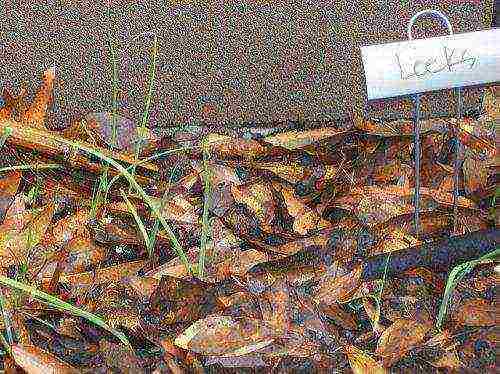
Leeks need to be planted at a distance from each other.
Planting seedlings
In the fall, fertilize the garden with organic matter and mineral fertilizers, such as overripe compost manure, potassium chloride, superphosphate. If the garden was not prepared in the fall, then in the spring add urea 14-16 gr., Or ammonium nitrate 17-22 gr. Make sure that the loose soil is not acidic. In the heated soil, thin out the ditches 13-16 cm deep and place the seedlings. The grooves are spaced 35-45 cm apart.
Do not plant the plant closely, so as not to replant in the summer. Spud the plant or mulch. If the mulch is tall, the stem will grow strong, tall and delicate in taste.
High and early varieties are recommended to be planted in a group of 3-4 pieces at a distance of 50-60 cm from each other. lettuce, celery and spinach. Serves as reliable protection of cabbage, carrots and strawberries from pests and diseases.

Leek repels pests from cabbage, strawberries and carrots
Leek care and feeding
Leek refers to a whimsical type of planting. For growing, choose a sunny bed, drain the soil. Planting needs proper care:
- thorough loosening of the soil between the rows;
- weed removal;
- periodic fertilization with minerals and organics;
- hilling or mulching the plant.
A month after planting seedlings, leeks are fertilized with special mixtures for onions. Proceed from the proportion of 3 liters per 1 sq. M. After 21 days, fertilize the plant with an organic supplement like diluted mullein or chicken droppings. Dilute thoroughly with water at least 15 times.
Use mineral fertilizers several times in one season. In the absence of specialized mixtures, mix 10 liters of water, potassium salt 15 g., And ammonium nitrate 15 g. Spray with a highly diluted mullein. Add wood ash to the grooves. Combine organic and mineral fertilizers until the end of summer.

You can grow healthy and strong leeks by combining mineral and organic fertilizers
Harvest
When there are several leaves on the plant, do a partial harvest. Remove the plants completely before the first frost.Dig in the base of the onion with a shovel, cut off the roots, they will remain as organic fertilizer.
The onion grows constantly, there is no break in growth. Experienced owners grow the plant in order to increase the growing period. They dig up onions in the middle of autumn, prune the roots and sprinkle lightly with soil in a greenhouse or greenhouse.
In late autumn and early winter, get a fresh plant if the temperature is +10 ° C.
Before the leek leaves turn yellow and the first frosts come, they dig it up, remove the rhizome and upper foliage. The peculiarity of leek is that it should be stored slightly tilted in the ground, in a cool place with a temperature of 0-1 ° C and an air humidity of 85-95%. If you follow simple rules, onions will retain their properties and freshness for six months. Another way to store the plant, but for a shorter period of time, is to put the onions in regular plastic bags, leave them open and refrigerate for 3 months at home.
Subscribe Be aware of new products on our site
Some 50-60 years ago, this crop was practically not grown in the post-Soviet space, underestimating its useful composition and considering agricultural technology to be difficult. It is difficult to believe in this today, when the varieties of leeks are numbered in dozens, and the plant itself is so in demand that it is second only to onions and garlic.
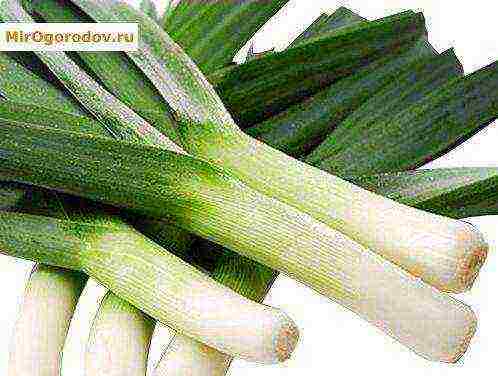
The most delicious and healthy of all cultivated onions
Royal bow, and not only because of the size
Leeks are two-year-old plants, although in the south of the country, where they are left in the soil for wintering, they can bear fruit as a perennial crop. It is valued for its long silvery-white oblong bulb (false stem or "leg"), which tastes much more tender and aromatic than onions, contains a lot of potassium, vitamins, and has a diuretic effect.
The plant starts slowly - the seeds germinate in small fragile shoots, the diameter of which, even two months after germination, does not exceed 2-3 mm. But after a couple of months, the leek strikes with royal, atypical for onion plants in size - up to 1.5 m in height and a food organ ("leg") weighing up to 400 g.
The long, flat leaves look like garlic and grow in a beautiful fan. The root system is powerful, fibrous type, if the plant is buried in sand or peat for the winter, it can feed it until spring. Kicks out the arrow and gives seeds in the second year of the growing season.
The size of the white stem depends on the variety and the timing of ripening - the stem is shorter but massive in late-ripening species, longer and thinner in early species. The white part can be increased artificially. To do this, use a special technique called "leg whitening" - the plant is spud several times a season, preventing the base of the stem from turning green.
Leeks are characterized by a long growing season: early varieties - 90–130 days, medium - 150–160, late –180–200 days. This feature is due to the agricultural technology of vegetable crops - in the conditions of the middle zone, the Urals, Siberia, the seedling method of growing is most often used.

A beautiful fan of leaves and a thick white leg are the hallmarks of the leek.
It is interesting! The best leek recipes come from royal Britain, France and Italy. Here it is put in a variety of salads, onion soups and mashed potatoes are prepared from it, baked with thyme and cheese.
Choosing varieties taking into account the ripening period
Modern breeding is aimed at developing new forms and hybrids with improved characteristics and earlier ripening periods, but old, time-tested leek varieties are also popular with gardeners.
Early and mid-early
For early production, fast-growing or summer varieties are planted. They begin to be harvested in August, some 85–90 days after seed germination. A characteristic sign of early maturity is a thin stem, the lightened part of which reaches 30-50 cm in length.Early products are usually used for summer consumption and processing.
- Columbus leeks are one of the best early maturing Dutch varieties with excellent taste. An adult plant is relatively short (70–80 cm), forms a stem up to 20 cm long, up to 6 cm in diameter, weighing up to 400 g. A big plus is that it does not need repeated hilling to bleach a productive organ.
- Leek Vesta is a domestic variety that is not inferior to the productive Dutchman. It begins to ripen after 120 days from sowing. The adult plant is powerful, up to one and a half meters tall, with a light green fan of leaves. If the vegetable is huddled several times, you get a grocery stalk 30 cm long and weighing up to 350 g. Vesta is appreciated for its special sweet taste. To get a guaranteed yield in regions with a temperate climate, it is recommended to grow the crop through seedlings.
- Leeks Elephant trunk is a variety with an eloquent name, which forms a bleached false stem up to 30 cm long. However, to achieve this, the vegetable needs to be spud several times. Has good quality of the bleached part, pleasant sweetish taste. It can be stored in sand for several months.

Planting of the Dutch variety Columbus
Mid-season
Medium ripening or autumn varieties form a thicker and more powerful “leg” 30–40 cm long. Their leaves are also large, bluish-green with a gray waxy bloom. If the plant is left in the soil and securely covered, after overwintering it will grow back and give seeds the next year. Mid-season leeks can be stored, but not more than 2–2.5 months.
- Leek Kazimir is a highly productive domestic variety, with a dense, good quality bleached "leg" up to 30 cm long and a weak onion. The plant is tall with almost vertical green leaves. The variety is sensitive to moisture, responsive to nutrition, the preferred method of growing is seedlings.
- Leek Winner is grown both in a one-year cycle and in a perennial crop for cutting fragrant and delicate greens. The plant is medium-sized, the leaves are gray-green with a bluish bloom, the white part is 3.5-4 cm in diameter up to 20 cm long. A distinctive feature is high frost resistance, which allows growing crops in cold regions.
- Leeks The elephant will give its first juicy stems within 130 days after sowing. It has high vigor of growth, expelling the aboveground part to a height of 1.5 m and forming a large food organ weighing 250-300 g. It is recommended to grow through seedlings and use the method of “bleaching the leg” by hilling the stem to a height of 20-25 cm.

Powerful plants of the Kazimir variety
Mid-late and late-ripening
With a growing season of 180-200 days, winter varieties do not have time to ripen in Siberia, the Urals and other regions where the frost-free period is no more than 150 days. Even in more southern regions, covering technologies are used in order to harvest the crop after wintering in early spring. The varieties are distinguished by a short and thickened bleached part, high cold resistance.
- Leek Alligator is a tall, powerful representative of a crop with a large "leg" weighing up to 300 g. It is also valuable for growing on greens with a delicate taste and pleasant garlic aroma.
- The Karantansky leek is one of the oldest varieties. Forms a spreading plant up to 1 m high and a food organ weighing 200-300 g. Selective harvesting begins after 125 days, reaching full maturity in 200 days. In order for the plant to mature before the cold weather, it is recommended to grow seedlings at the age of at least 70 days.
- Leek Bandit - a variety, despite its unusual name, was bred by the Dutch. This is a beautiful tall plant with dark green foliage, shimmering blue. The stem is short, thickened, with excellent taste. Due to its high cold resistance, in regions with a mild climate, they are harvested in late autumn or even after overwintering - in early spring.
- The Autumn Giant Leek is another Dutch variety.Forms a large white "leg" (30-40 cm) in cross-section up to 8 cm. The harvesting period is extended for one and a half months. Differs in good keeping quality.
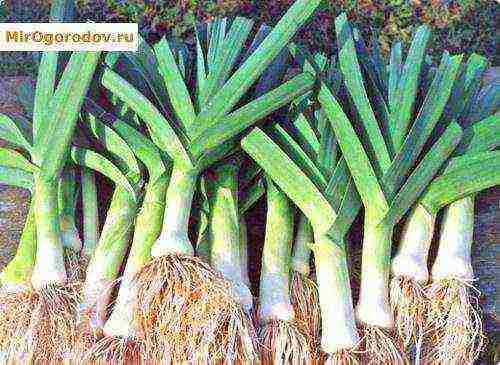
Time-tested and harsh climate of Russia leek Karantansky
Zoning varieties
According to the results of variety testing, the characteristics of cultivation and the useful return of the assortment of vegetable plants are determined. Speaking of leeks, the most suitable varieties for the Moscow region belong to the early and mid-season group. These are Vesta, Casimir, Columbus, Elephant, Goliath, Tango. From late-ripening varieties, it is better to give preference to plants with an extended ripening period, for example, Karantan or Autumn Size.

Vesta will delight you with a good harvest both in the Moscow region and in Siberia
In colder regions, late varieties will most quickly have to be abandoned or transplanted in a heated greenhouse in late autumn. Of all the variety of leeks, the best varieties for Siberia are early Vesta, Columbus, Goliath, mid-season Lancelot, Tango, Winner.
From the video below you can find out more about leeks, their varieties and cultivation features:
Moscow, Russia, on the site since 11.01.2017
Have you read it? Don't forget to rate
(
estimates, average:
out of 5)
For many gardeners, leeks are a relatively new crop, so choosing the right variety can be difficult. They differ markedly both in taste and in terms of ripening. Find out about the best leek varieties and find the one that best suits your needs!
Early and mid-early
Early ripe leeks are especially good for planting in northern regions where the heat does not last long, for example, in the Urals. Usually they are used fresh and for conservation.
Columbus
Columbus leeks have a pleasant, delicate flavor. A very early variety, ripens in 85 days. Cold resistant. The maximum height is 70–80 cm, the length of the stem is 20–30 cm. With good care, the weight of a plant can reach 400 g. Unlike a number of other varieties, Columbus does not need to be spud to bleach the stem.
Vesta
Vesta leeks are characterized by a semi-sharp, sweetish taste. Resistant to disease, heat and frost, but requires regular hilling and feeding. In temperate climatic zones, it is recommended to plant through seedlings (on the 70th day after sowing the seeds). Plant height - up to 100-150 cm, and the white part with 2-3 hilling per season reaches 30-50 cm. The bulb is poorly expressed, of medium density. High-yielding variety. Can be eaten fresh, dried, frozen and canned.
Elephant's trunk
With regular hilling of leeks, the white part of the elephant's trunk grows up to 30 cm. It has a sweetish pleasant taste. The advantages of the variety include a long shelf life - up to several months in the sand (in an upright position). In the southern regions, sowing directly into the ground is allowed. In cold and temperate regions, seeds are planted for seedlings at the end of February, at the beginning of May they are transplanted into the ground.
Mid-season
Mid-season varieties are characterized by a more powerful stem and larger leaves. They can be stored for 2–2.5 months. If such a bow is left in the soil, covering it securely, the next year it will throw out an arrow that will give seeds.
Casimir
Productive variety with little or no bulbous part. White leg - from 20 to 30 cm. The leaves are almost vertical. Eaten fresh or dried. Reacts well to storage, while becoming juicier. Sensitive to watering and feeding. Best grown in seedlings.
Winner
Leek Winner is distinguished not only by a juicy, slightly sharp leg, but also by delicate greens with a pleasant aroma. Can be preserved and consumed fresh. Winters well. The white part reaches a height of 20 cm with a diameter of 3.5-4 cm. The average weight is 200 g. Leaves with a gray tint and a bluish bloom.
It ripens in 130–160 days, depending on the soil and weather. Resistant to frost, making it a good choice for northern areas.
Elephant
Leek Elephant (Elephant) belongs to the Czech selection. An adult plant reaches a height of 150 cm. The leaves are wide, bright, blue-green. Resistant to high and low temperatures.
Leeks The elephant ripens for about 130 days. Once harvested, it can be stored for 60–90 days. The taste is spicy, pronounced. Suitable for fish and meat dishes, soups and salads.
Yielding variety: with proper care from 1 sq. m, you can collect up to 4 kg of onions. It is recommended to plant in seedlings. Demanding on moisture and hilling, loves feeding.
Mid-late and late-ripening
The growing period of late-ripening leek varieties ranges from 180 to 200 days. Such varieties are resistant to cold, therefore, in temperate and southern regions, they are often left for spring harvesting. The bleached part is predominantly thick and short.
Alligator
Alligator leeks weigh up to 300 g. The white part is up to 30 cm. Not only the leg, but also the greens, which have a slight garlic smell, have a good taste. Can be used fresh and canned. Leaves are raised, set high. From 1 sq. m can be collected on average 3.4 kg.
Karantansky
Large spreading plant up to 1 m tall. The productive part weighs up to 300 g. The variety has excellent taste, gives fresh greens until frost and winters well, due to which it is suitable for the Ural climatic conditions.
Full ripening time is 200 days, spot harvesting can be started after 125 days. For most areas, it is recommended to grow seedlings - preferably at least 70 days before planting in the ground.
Bandit
Dutch variety. The short, thick stem tastes great. The leaves are folded along the main vein. On average, the height of the white part is 7 cm, but correct mulching or hilling can "raise" it up to 30 cm. The variety is frost-resistant, suitable for harvesting in late autumn and spring. As with other late varieties, seedling is recommended. Needs fertile soil and regular watering.
Autumn giant
The Autumn giant onion is distinguished by a particularly large white part - up to 40 cm in length and up to 8 cm in diameter, but to obtain such a result it is recommended to hilling 3-4 times during the growing season. Total height - up to 80 cm. Ripening time - 150-200 days. Drought tolerant. Average yield - 3-4 kg per 1 sq. m.
The autumn giant has good keeping quality. The taste is semi-sharp. The "giant" variety is suitable for fresh consumption, soups and salads. You can freeze.
Video "Growing leeks"
The author of this video shares his experience of planting, growing and harvesting leeks on his site.
Improving appetite and accelerating the metabolic process, normalizing the functioning of the liver and gallbladder, improving the functioning of the nervous system, restoring memory, coordination of movements and attentiveness - all this is just a part of the beneficial properties of leeks with a sweet and delicate taste, which is unfairly offended by the attention of consumers in our country.
Plant features
The main nutritional value of leeks is represented by the white leg. The early young leaves of the plant, which are similar to our usual garlic leaves, can also be eaten, as they are also enriched with minerals and vitamins. The size of the leg largely depends on the growing conditions, as well as on the variety of leeks and can vary in height from 15 to 45 cm, in width - from 3 to 8 cm. Leeks can be stored for up to six months without losing their vitamin properties. It is imperative that you cut off the roots and leaves. The seeds of this onion are smaller than those of the onion species and remain viable for 3 years. And he does not form bulbs, like that of a fellow onion.
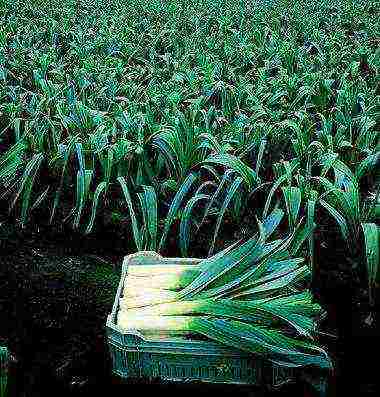
Leek varieties are cold-resistant. They are not afraid of frosts down to -8 ° C. Therefore, in the open field, it can be from early spring to late autumn.
Leeks: varieties, photos
From the beginning of sowing to the emergence of shoots, this plant needs 2-2.5 weeks.Leek varieties by ripening rate are divided into:
- early;
- medium;
- late.
Early plant varieties
Usually, late varieties of vegetables are considered the most productive. However, leeks have the highest yields in the early varieties. Early maturing varieties can be tasted in late summer or early autumn. They take an average of 140 days to ripen. Their leg is quite thin, no more than 3 cm in diameter. Does not tolerate cold very well. In the south, you can safely and freely grow such a leek. Early maturing varieties are presented:
- Vesta, which ripens in about 130 days. It is quite resistant to diseases and parasites. The taste is semi-sharp. The length of the bleached stem is about half a meter. From 1 m² can be harvested from 3 to 6 kg of leeks. In addition to fresh consumption, it can be canned, pickled and frozen.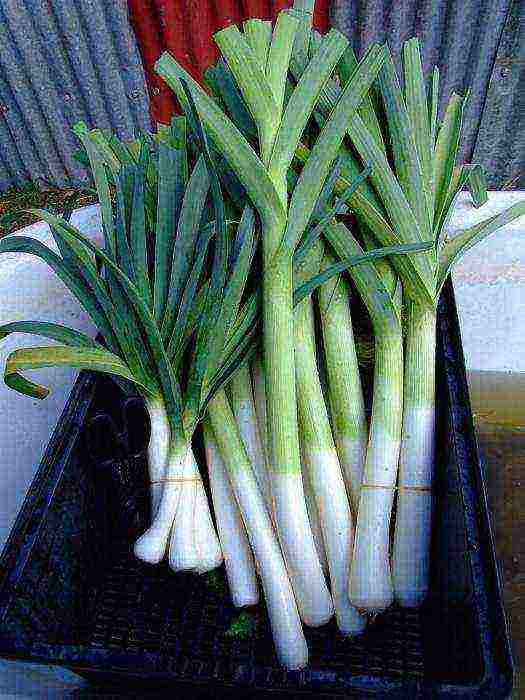
- Goliath, in which the diameter of the bleached part is almost twice as large as Vesta and is 5-6 cm. Acceptable for drying and fresh consumption.
- Kilima with a growing season of 150 days. Harvesting will be possible from the middle of summer. It is a disease resistant leek.
Early varieties are loved by exhibitors for the opportunity to sow them under glass at the beginning of the year and demonstrate them in September.
Medium plant varieties

Mid-season varieties have an average growing season of 160 days. Their yield is less than that of early maturing species, but the quality is much better. Harvesting autumn varieties should be in September. Mid-season varieties have the largest number of varieties. Often it is this leek that remains in the garden for the winter. The best varieties are presented:
- Bastion with a growing season of 155 days. Very productive, high yield. The weight of the bleached stem is about 200 grams, the length is 30 cm.
- Jolant - relatively resistant to fungal diseases of plants. The bleached part is medium in size. The yield from 1 m² will be about 5 kg.
- Casimir - a tall plant with good quality bleached stems, 25 cm long and 3-3.5 cm in diameter. Approximately 180 days should elapse from the sowing period to the time of harvest. The yield is not too high, it will be 3 kg per 1 m².
- Tango. It has a growing season of 150-160 days. Productivity is high. It tolerates cold well.
- Kamus - a low, compact species with a height of 20 cm and a diameter of a little more than 2 cm. Its taste is weak. The yield is small.
- Lancelot with a beautiful, thick, medium bleached stem. It tolerates frost well. It is recommended to consume fresh, store up to two months. He especially loves hilling.
- Elephantom MC with a spicy taste and a leg length of 10 to 25 cm. Does not require a lot of moisture.
Late plant varieties
Winter varieties have good resistance to cold and frost. The growing season is long, from 180 to 200 days, and often the plants do not have time to complete their growth, therefore they have a short bleached part. Growing winter varieties is good in a greenhouse. Some gardeners transplant the plant into grow boxes before frost. The following winter varieties are most common:
- A bandit with a short white stem. Direct sowing of seeds into the soil can be carried out at the end of July.
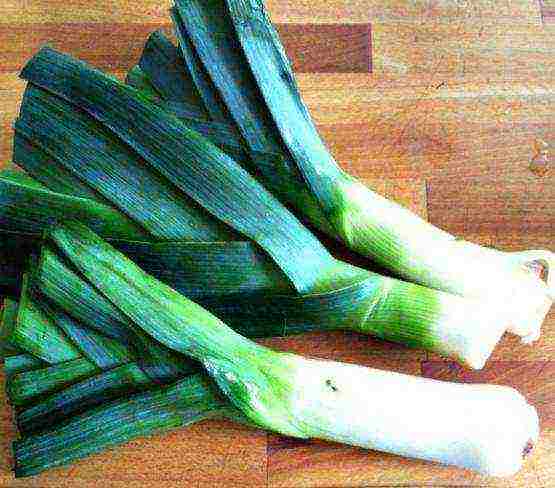
- Mercury. The growing season takes 175 days. The height of the white stem is 20 cm. It has a delicate, slightly pungent taste. Resistant to viral disease.
- Quarantine. Good yield, especially in the second half of September. Differs in good taste and a cylindrical stem 5 cm wide.
Storing leeks
The leek is harvested for the winter a few days before the start of frost. You can store onions in your basement or refrigerator. In the basement, it is best to choose an upright position for the bow. The roots are sprinkled with slightly damp earth or sand, the most common, but also slightly wet. You can trim the roots, but not completely. Without roots, the onion quickly deteriorates and begins to rot.Trim the leaves by a third, leaving most of the greens to feed the bleached portion. If you do not cut them off, they will still dry out and at the same time will still cause inconvenience during storage. Storage temperature - 0 ° C.
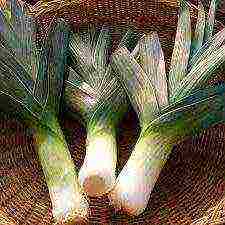
Leek varieties are distinguished by good adaptability to different growing conditions, the length of the growing season, yield, size and weight of the bleached leg. Its cultivation is, of course, painstaking business, but our health is worth it.

